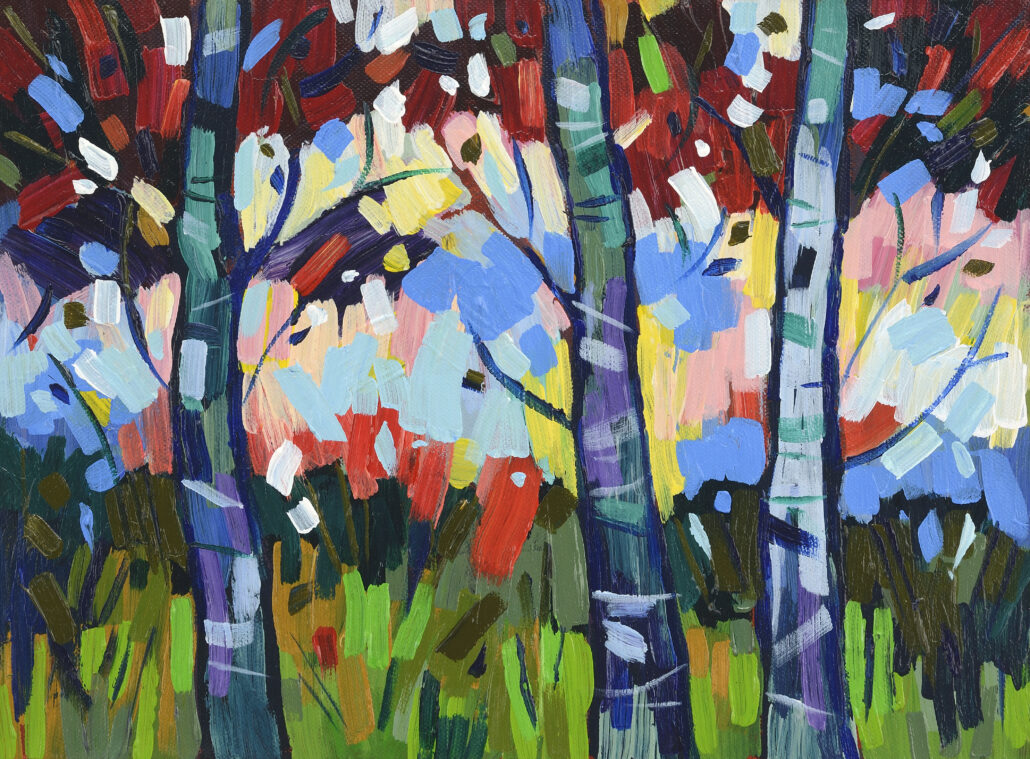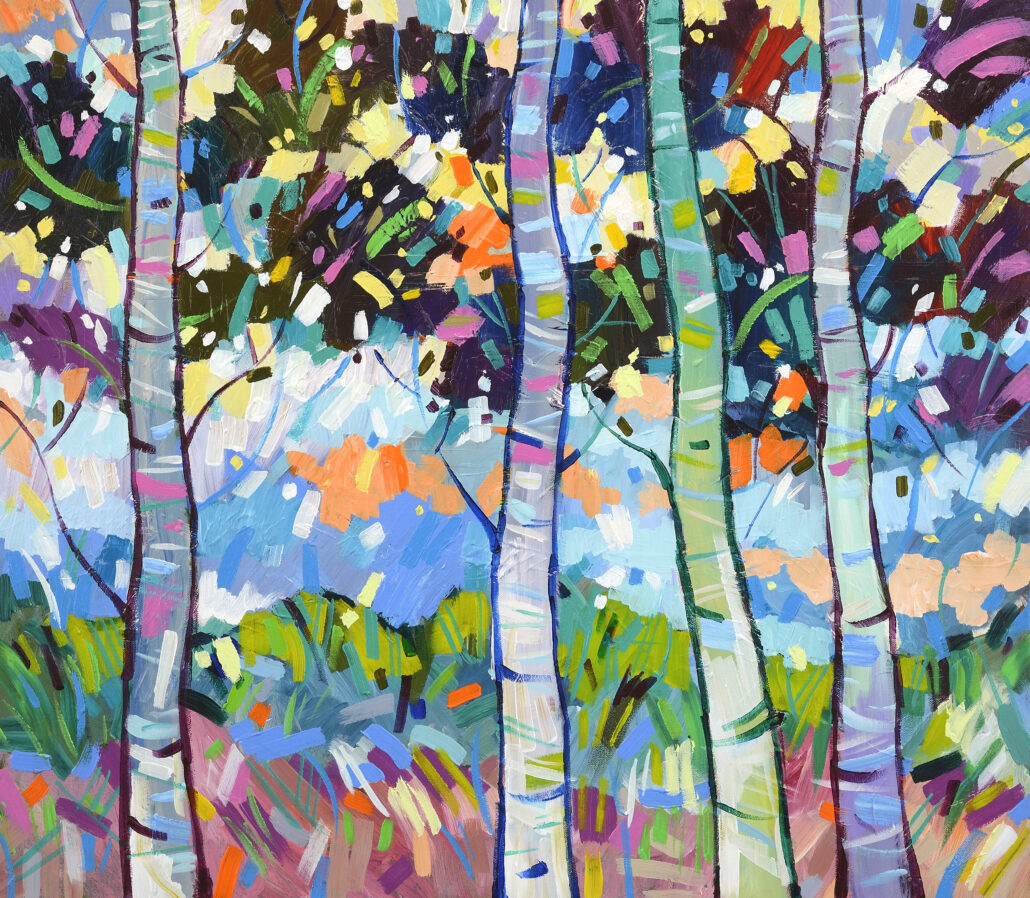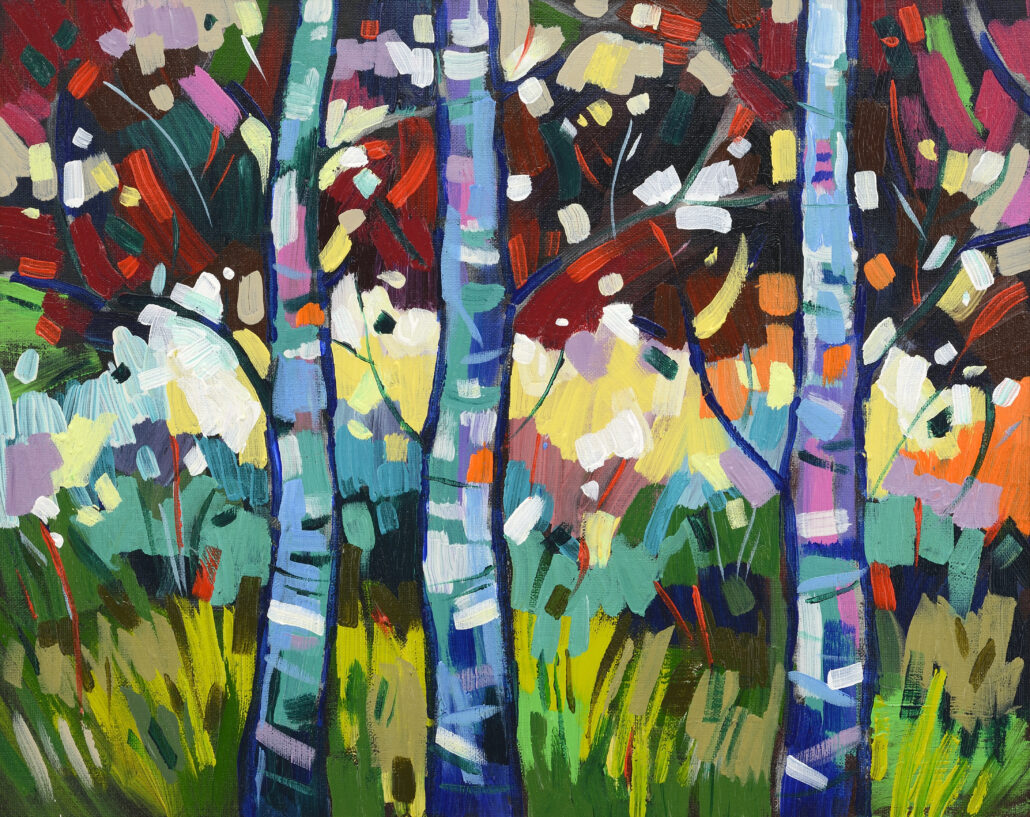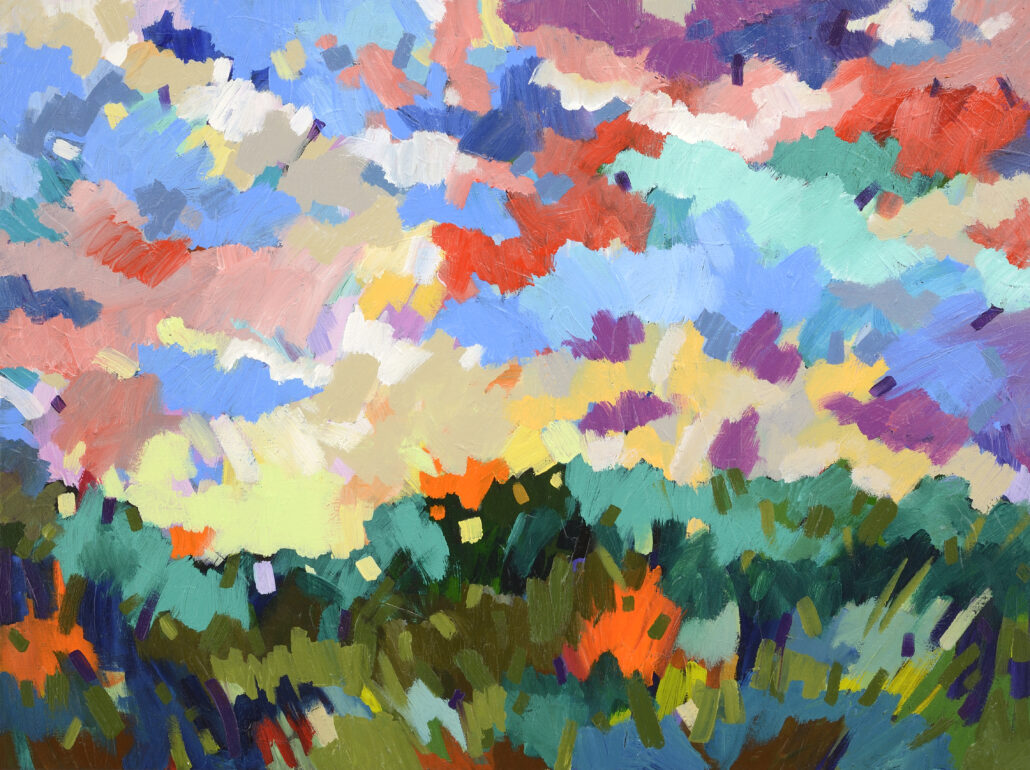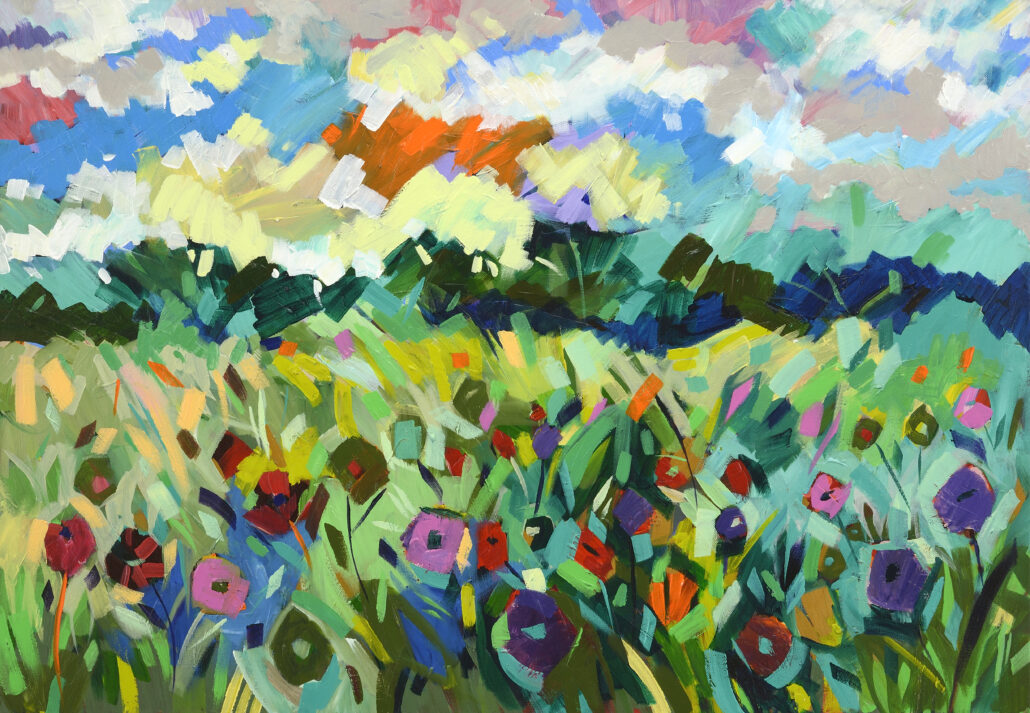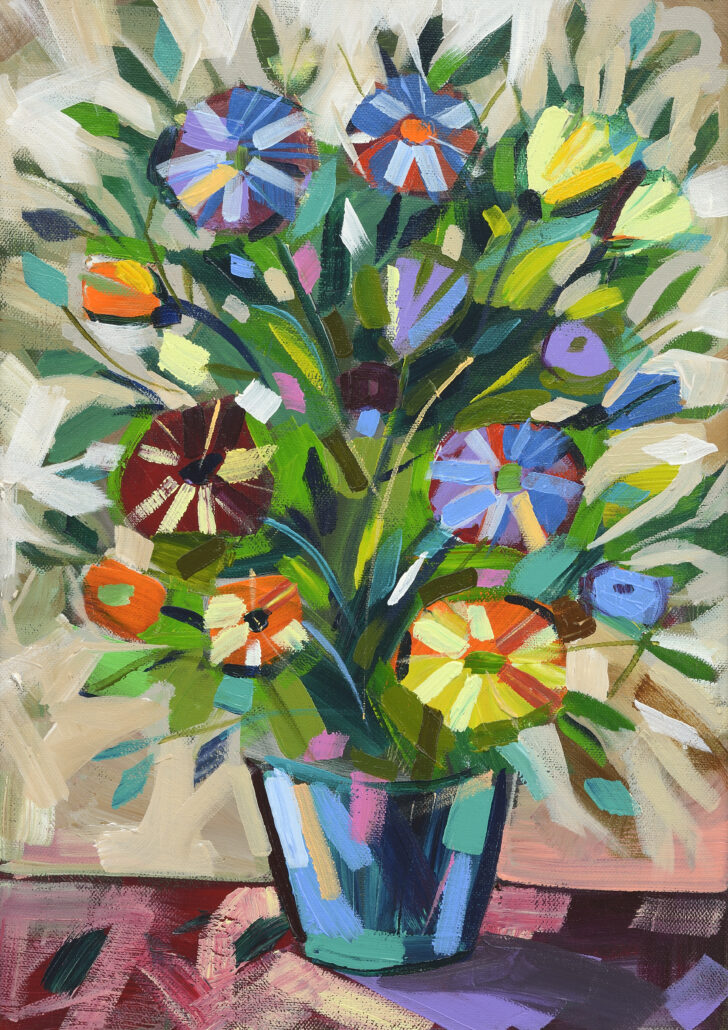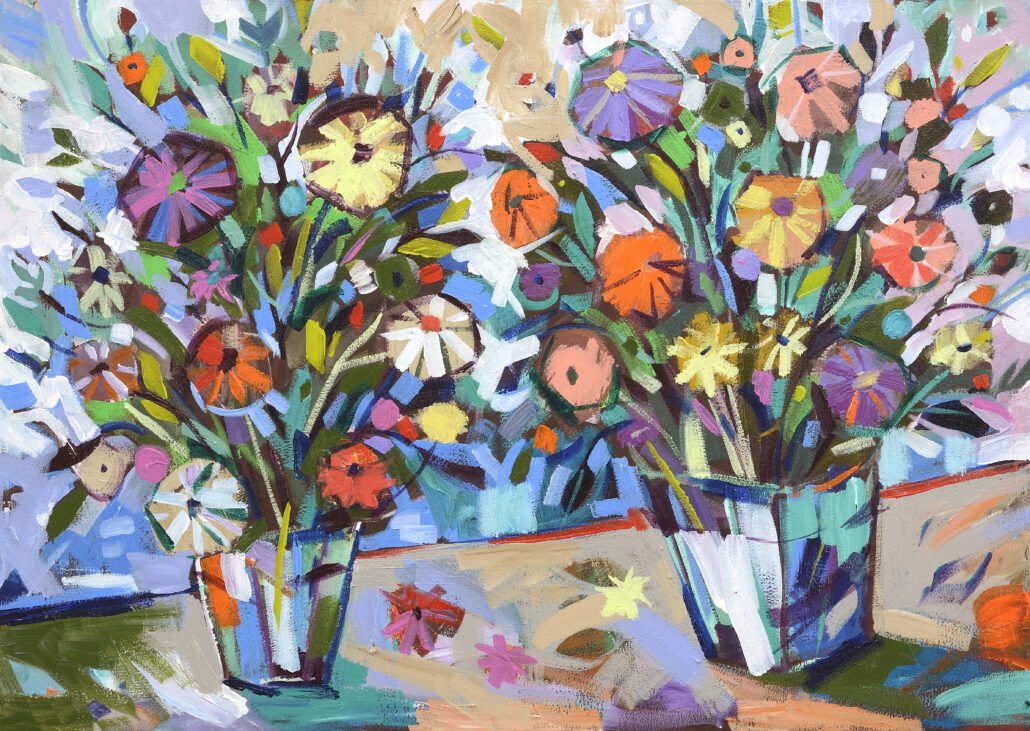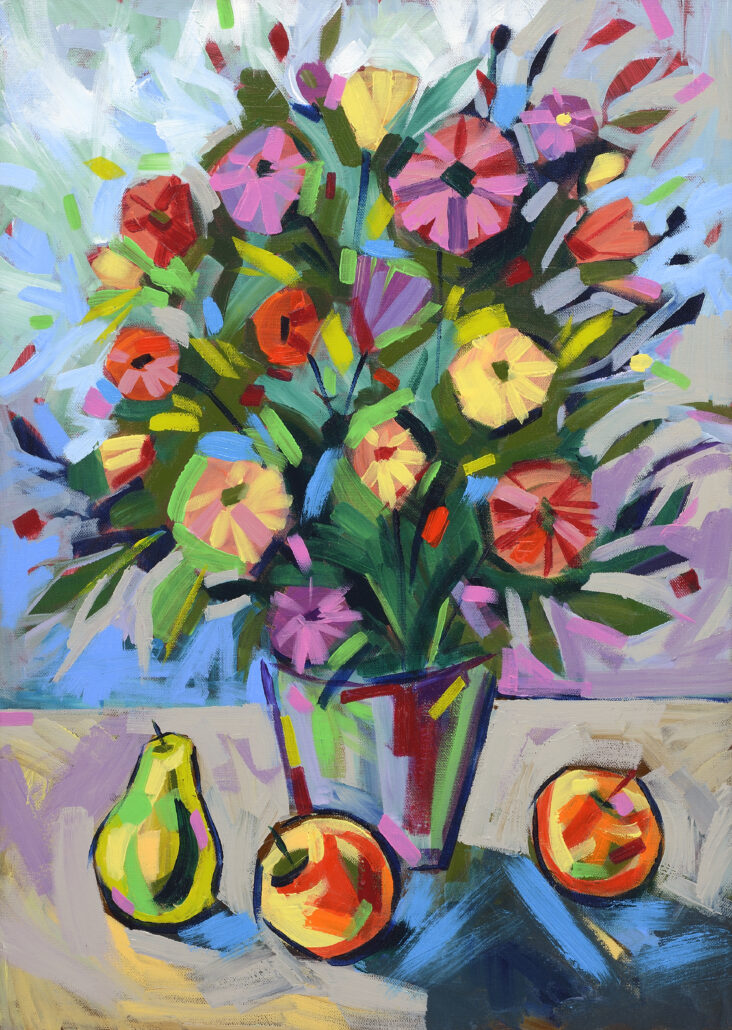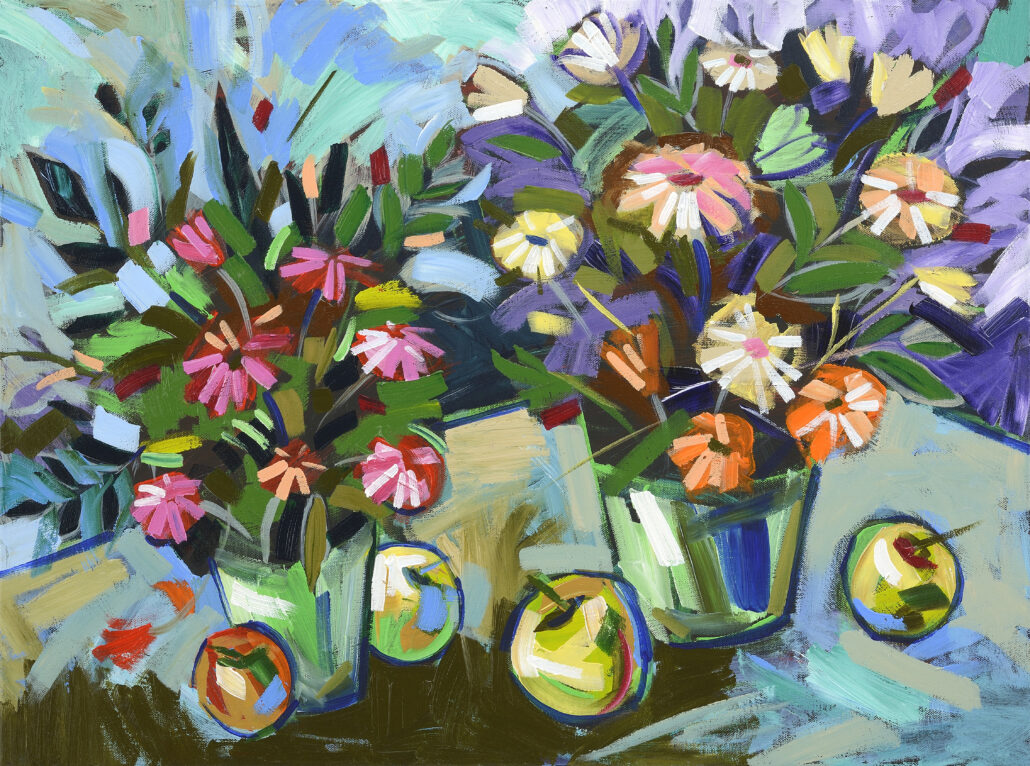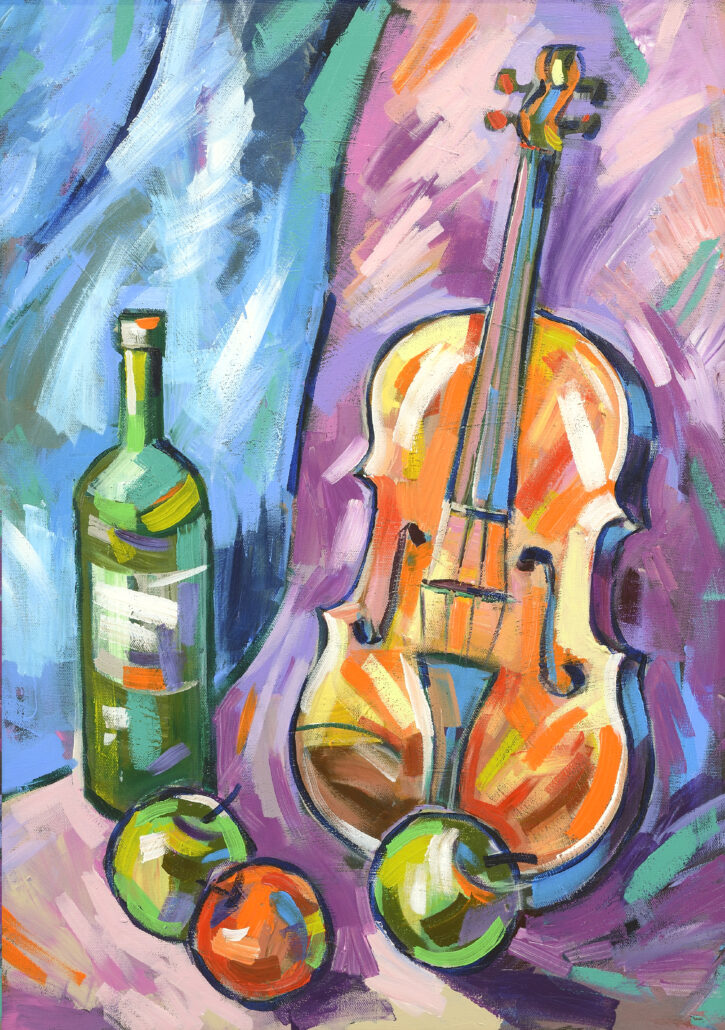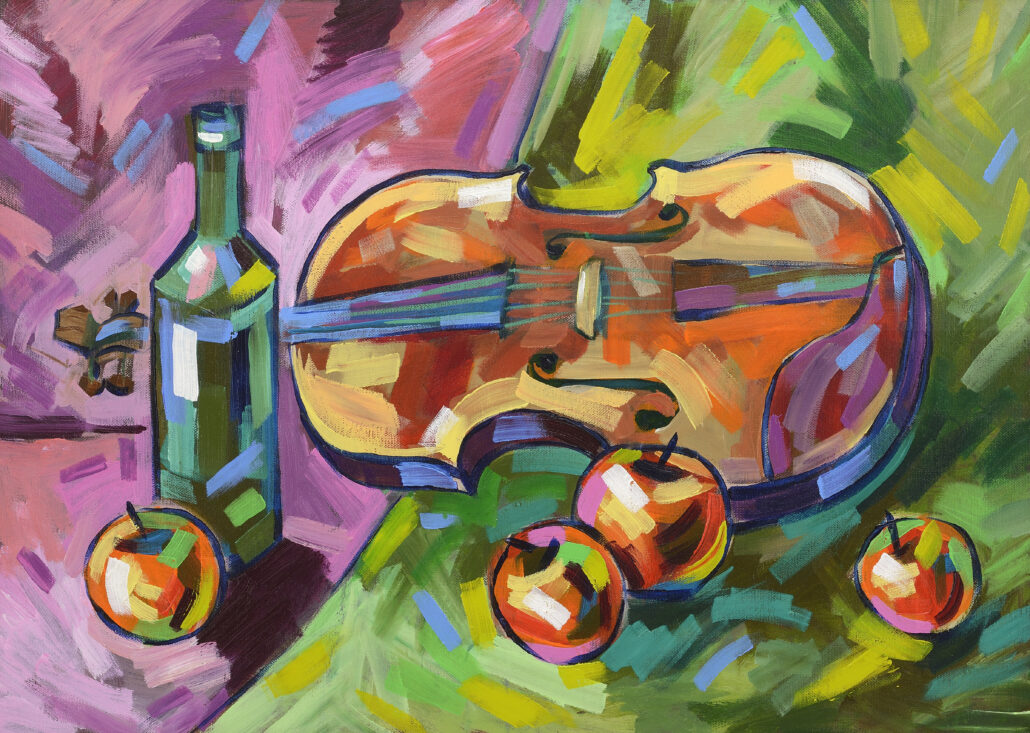Exhibition of paintings at Enakor Auction House, 21-29 March 2024.
Curator Rossitsa Gicheva-Meimari
Enakor Auction House has several missions. One of the most valuable is to give a space for young artists to exhibit. On March 21, 2024 we are opening the third solo exhibition of Emma Yordanova – a graduate of New Bulgarian University, art historian and artist, young painter with her own distinguished signature.
Emma’s signature is characterized by the painterly allusion to stained glass, through the light that seems to pass through the bright acrylic paints and emanates from all its tones, except the darkest ones, which in turn create an allusion to the metallic surrounds of the stained glass pieces, because they are mostly linear and contoured. Its characteristic large, dense, thickly textured, three-dimensional, rectangular strokes, cut as if with a knife, create – on the other hand – the allusion to mosaic. In her own way, she has taken what she has learned about painting, stained glass and mosaic, and combined-weaved it into a unified whole, achieved solely by the means of acrylic paints. This is what I define as her personal signature, which she arrived at about five or six years ago and continues to develop, as we see in the works in this exhibition.
After the interview I did with Emma (link to text 1), I also understand two other features of her manner, which I could detect from the very beginning of her creative career, but could not understand well at the time. The mathematics school she graduated from explained the strong mathematical thinking that is evident in her work from afar even at a cursory glance – the straight lines and angles, the exquisite geometric shapes even of the brush strokes, the perfect perspective, the perfect proportions and composition, the mastery in calculating the proportions of the mixed paints to get the complex paint tones.
Emma’s sharing about the important role of music in her life and especially while painting, explained to me why I always have a sense of music when I look at her paintings. There is also a lot of mathematics in music, and it seems Emma’s mathematical thinking has given her another tool for even more sophisticated transformation – of music into painting. Emma seems to have been gifted with the most fruitful ability to create in any field – the ability to turn one thing into another thing, I’ll call it metaphorically an “alchemical” ability. Like a magician-alchemist, she transforms mathematics, music, stained glass and mosaic into painting. That’s why I called her exhibition “The Music of Landscapes and Still Lives”.
What musical-pictorial works you will see in Emma Yordanova’s exhibition
Forest landscapes
Forest Landscapes most fully represents the signature of Emma Yordanova, whose characteristics I have outlined above. She works with shimmering colours – the strokes seem to be made of glass and the light passes through them, creating the allusion to stained glass, which is further enhanced by the clear dark linear outlines. On the other hand, the strict straight and rectangular shapes of the strokes give a sense of the mosaic characteristic of large stones. Since the “stones” are light-transmitting, I would liken her woodland landscapes to stained-glass mosaics of precious stones.
On the other hand, the brushstrokes are like colorful note-tones in the score of a classical symphonic work. In the forest landscapes, the trees in the foreground are the solos and the background is the orchestra. Performance time flows from left to right. In the orchestra-background time flows in long and dense stroke-tones. In the upper half of the canvas the stroke-tones are broad, rarely breaking out of their strict rectilinear boundaries, while in the lower half of the canvas they are narrower and, in places, even linear. In the orchestra-background, the stroke-tones move-sound vertically or diagonally, as do the voices of the various musical instruments in the orchestra. In tree solos, timing and performance is strictly limited by vertical contours, as their parts appear in classical musical compositions. They move along a narrow band from bottom to top in short and distinct horizontal or less frequently oblique strokes of varying width, but always much narrower than the background strokes. Although rare, it happens that some strokes lose density and sound “hoarse,” like the yellow strokes at the base of the canvas in “Autumn Landscape with Three Trees I.” The complex painting tones are often obtained by layering transparent strokes rather than preworking the palette. Quite often the artist uses pure colors, which gives the canvases their great brightness.
Emma Yordanova hardly develops the three-dimensional space and the voluminosity of the objects in it (sometimes partially – the trunks of the trees). The perspective cuts are excellent, but the plans are highly condensed, like a collected accordion. The only exception is “Autumn by a Forest Lake,” in which the plans are relatively more expansively developed in depth.
The wide-horizon landscapes
Wide-horizon landscapes are a new subject for Emma, one in which she is still in the early stages of experimentation. Here she works less with rectangular rectilinear strokes and more with very large patches of complex shapes, now less strictly linear. Insofar as I have known and followed Emma’s work since her first student exhibition at New Bulgarian University, I can notice a movement from smaller to larger strokes. The mosaic surface, familiar from her previous paintings, has here been transformed into a kind of “patchwork” – a more complex and more difficult expression for the viewer to perceive the forms. Perhaps the artist is beginning to attempt a shift to a more abstract style? Through these large multiform patches she is also experimenting with obtaining more complex pictorial tones. These paintings use the relief layering of paint as individual artistic elements. For example, in “Summer Landscape I,” trees seem to be painted in the first painting layer with very large layering of paint at the outlines. Then, when the second painting layer is applied, patches of color are applied over them, as they are in the background. These spots completely hide the images of the trees. What remains, however, are their three-dimensional outlines formed by the paint layered over their contours in the first layer. This creates a very curious and interesting appearance of the work – some ghostly relief images float around the space of the painting. The canvas has become as if in a visible palimpsest, resembling two photographs taken on top of each other on the film. I don’t know if it’s an accidental or a wanted effect, but it’s still very successful.
It looks and sounds to me as if Emma has painted the wide-horizon landscapes against a background of calm, mellow, slow hypnotic jazz, whose long improvisations on a theme have become huge painterly patches of varying shapes. Time in them flows in one direction, bottom-up. In contrast to the forest landscapes, here everything is presented in a very clear and strongly directed movement – slower and more solemn in the landscapes without flowers, and faster, even accelerating, in the landscapes with flowers. I assume that the landscapes without flowers are painted to instrumental music, and the landscapes with flowers are painted from a group/choral performance accompanied by instrumental accompaniment.
Pots with flowers
In the still lives with pots of flowers I see painted songs – probably by Emma’s favourite jazz artists. In the one-pot paintings I see-hear a solo performance, in the two-pot ones, duets. In these, time, represented by stroke-tones of varying width and length, flows from bottom to top, as in the soloists of the symphonic works, but here there are no strict constraints of contours, as in the trees – shortly after the beginning, the flows start to spread out in different directions, or burst out in all directions, until finally they pass into the background as well. In these paintings the complex dynamics of musical performance with a human voice are much more clearly represented, as opposed to purely instrumental performance: because it is observed from a short distance, one can see everything moving and vibrating, except the pots, even (and even especially) the air and the walls vibrating.
In her paintings Emma Yordanova manages to figuratively render the physical essence of sound – vibration of matter, including air. That is why I am quite sure that through her landscapes and still lives she has painted the flow of the music she likes to listen to while painting. The same, only in reverse, has been said of her favourite composer, who created the Impressionist movement in classical music, Claude Debussy. Composer Edgar Varese believed that “Debussy is the greatest link between fine art and music” (Todorov 2024).
Yordanova has succeeded in both representing the vibrations of matter and translating musical tone into pictorial tone (through colours, colour harmonies and contrasts, density or hoarseness, pitch-light). She has also come to grips with tempo and the length of musical time – expressing them with rhythm, the length and width of her mathematically measured strokes. The mood is evident in the general vibe of the whole paintings – it is overwhelming, upbeat, cheerful and radiant, as Emma herself is as a person, as far as I know her.
In the still lives, which also include fruit, I see a representation of dance – unlike most other images, the fruit is represented three-dimensionally, without which characteristics dance cannot be represented (unlike music, for which two-dimensionality is quite sufficient). It is interesting that the pears, which Emma rarely represents, are always straight and still, while the many apples are always wobbly in some direction. In the compositions of the fruits, one can clearly see groupings of apples, keeled in the same direction, juxtaposed with another group or a single fruit that has keeled in the opposite direction. Usually their handles are also tilted in the direction the whole fruit is tilted – this shows a certain clear choreography in the dance of the fruit in each painting. There is only one confused apple that tilts in the opposite direction to the tilt of its handle and stands very strangely and detached from the whole composition – in Still Life with Viola II. It probably has some special meaning that only Emma can explain to us.
The musical instruments
It is no coincidence that I placed the two paintings with violas at the end of the exhibition – because they substantiate and literally nail the musical interpretation I made on Emma Yordanova’s landscapes and still lives. These still lives, however, are a little different. They have a lot of rounded shapes and lines – both on the apples (which are angular in the other still lives) and the viola, and on the empty bottle. Here Emma moves slightly away from her usual angular forms. Perhaps the subject represents human communication through these rounded shapes, volumes and lines, through the music, the dancing and the wine drinking (I keep seeing the apples as dancing because they are not a suitable appetizer for wine). And maybe there is a love emotion in these subjects too – with the female forms of the viola and the male forms of the wine bottle? If so, the mood here seems not as upbeat and cheerful as in the other still lives, but a little confused and problematic – the bottle is empty, the apples are not in good synchronization as in the still lives with pots of flowers. Each apple is leaning towards another which is leaning towards a thrid, there are isolated ones and one completely messed up apple as I have already described. And there could be nothing problematic, just that the dancers are drunk from the wine they have drunk, as the viola reclining on two chairs in Still Life with Viola II suggests.
Years ago Emma painted many more still lives with musical instruments. One of them, very favourite and very suitable for my character and taste, was on the wall behind me in my office at New Bulgarian University (unfortunately, I could not own it). The composition had a dramatic and contradictory character – a metal brass instrument, a box of paint brushes, a skull, and maybe apples. Clearly, life and personality changes have led the artist more definitively in the direction of idyllic beautiful landscapes and still lives, and have taken her away from the dramatic and controversial subjects of a time, which is actually very nice. Emma has taken a steady course in a radiant, poetic, tender, romantic, amorous direction, embodied in the beauty of nature, which best suits the character and temper of her personality. I am sure this will appeal to many connoisseurs of painting, as has always been the case in her previous exhibitions. There has never been an Enacor auction in which Emma Yordanova participated and her paintings were not bought. She has her loyal connoisseurs and admirers, which are sure to increase after this exhibition.
Rositsa Gicheva-Meimari, PhD
Senior Assistant Professor in the Art History and Culture Studies Section and member of the Bulgarian-European Cultural Dialogues Center at New Bulgarian University
Bibliography Todorov 2024: Найден Тодоров, Клод Дебюси – “На концерт с БНТ 2”, 27.01.2024. https://youtu.be/autwa1QohNc?si=Vv3xJR-ynbcZuuqt Посетена на 20 февруари 2024 г.

